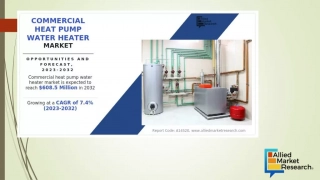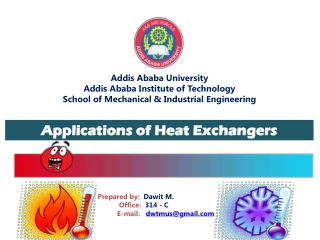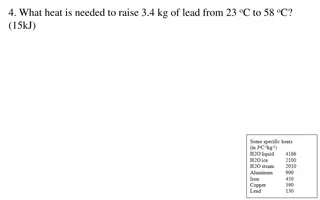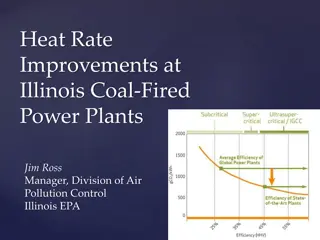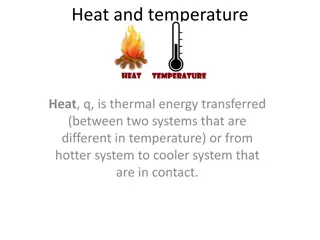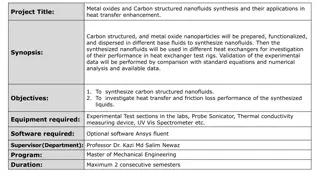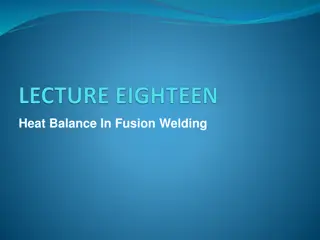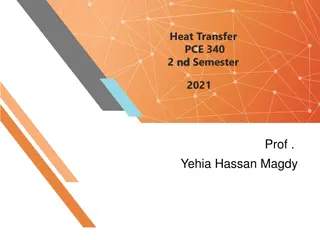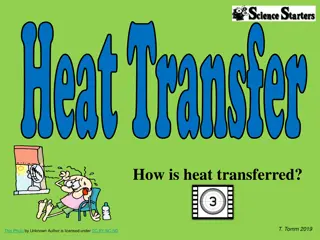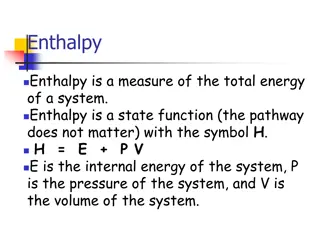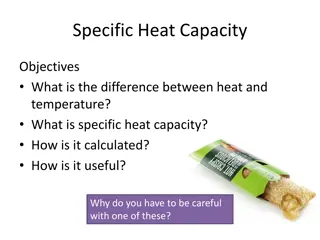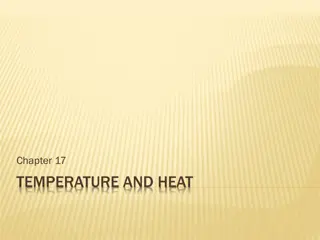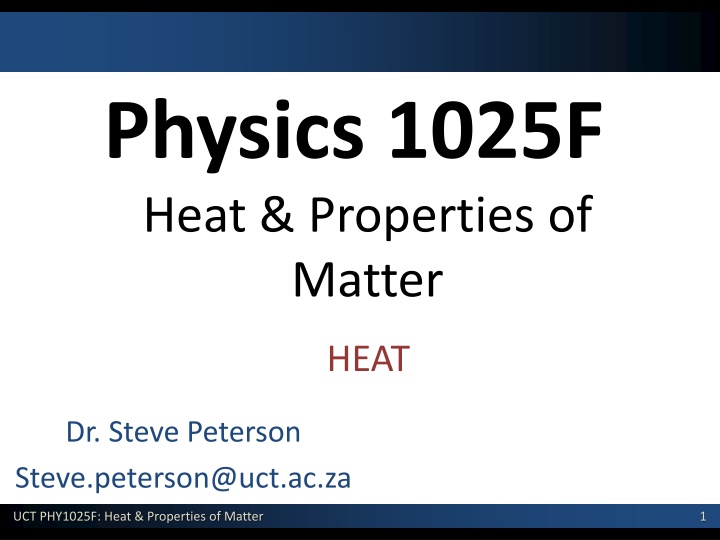
Heat and Properties of Matter in Physics 1025F
Explore the concepts of heat, temperature, thermal energy, and internal energy in Physics 1025F. Learn about the transfer of energy due to temperature differences, the relationship between temperature and kinetic energy, and the definition of heat as thermal energy flow. Discover the units of temperature measurement and the SI unit of heat, as well as the distinction between temperature and heat. Gain insights into the nature of heat and its effects on matter in this comprehensive study of thermal properties.
Download Presentation

Please find below an Image/Link to download the presentation.
The content on the website is provided AS IS for your information and personal use only. It may not be sold, licensed, or shared on other websites without obtaining consent from the author. If you encounter any issues during the download, it is possible that the publisher has removed the file from their server.
You are allowed to download the files provided on this website for personal or commercial use, subject to the condition that they are used lawfully. All files are the property of their respective owners.
The content on the website is provided AS IS for your information and personal use only. It may not be sold, licensed, or shared on other websites without obtaining consent from the author.
E N D
Presentation Transcript
Physics 1025F Heat & Properties of Matter HEAT Dr. Steve Peterson Steve.peterson@uct.ac.za UCT PHY1025F: Heat & Properties of Matter 1
Chapter 14: Heat What is heat? Heat is defined as a transfer of energy due to a difference in temperature UCT PHY1025F: Heat & Properties of Matter 2
Temperature, Thermal Energy & Heat Temperature, thermal energy, and heat are related to each other, but they are not the same thing: Temperature is a measure of the average kinetic energy of the atoms/molecules in a substance Thermal energy is the sum of kinetic energy of each atom or molecule in a substance Heat is the energy transferred due to a difference in temperature UCT PHY1025F: Heat & Properties of Matter 3
Temperature Temperature is a measure of the average kinetic energy of individual molecules. it determines how hot or cold something is and which direction the heat will flow Three common units are: Celsius: water freezes at 0 boils at 100 Kelvin:0 is absolute zero (-273 C) Fahrenheit: only Americans and Brits use it UCT PHY1025F: Heat & Properties of Matter 4
Thermal (or Internal) Energy Thermal energy is: the sum of all the kinetic energy of all the molecules in a substance is its thermal energy (U). Temperature is related to the thermal energy, as a measure of the molecules average kinetic energy. is the thermal energy of a monatomic ideal gas (with temperature in Kelvin) UCT PHY1025F: Heat & Properties of Matter 5
Heat DEFINITION OF HEAT Heat Q is thermal energy that flows from a higher-temperature object to a lower- temperature object because of the difference in temperatures SI Unit of Heat: joule (J) The direction the heat flows depends on the temperature of the two surfaces in contact. Note: It is not correct to say that a substance contains heat! UCT PHY1025F: Heat & Properties of Matter 6
Units of Heat A common unit of heat: calorie (cal) 1 cal is the amount of heat necessary to raise the temperature of 1 g of water by 1 Celsius degree. In the 1800s, Joule calculated the mechanical equivalent of heat: UCT PHY1025F: Heat & Properties of Matter 7
Heat: Conservation of Energy Law of Conservation of Energy for Heat If there is no heat loss to the surroundings, the heat lost by the hotter object equals the heat gained by the cooler ones. Isolated System: Q lost by some contents = Q gained by rest UCT PHY1025F: Heat & Properties of Matter 8
Where does the Energy go? When energy is added to a substance what happens? OPTION 1: the object s temperature may increase OPTION 2: the phase of the substance may change OPTION 3: the substance may use that energy to do work (i.e. expand) First Law of Thermodynamics UCT PHY1025F: Heat & Properties of Matter 9
Specific Heat OPTION 1: HEAT SUPPLIED OR REMOVED LEADS TO A CHANGE IN TEMPERATURE What factors will influence the temperature change? Depends on: - Heat transferred (Q) - Mass of objects (m) - Property of materials (c) specific heat UCT PHY1025F: Heat & Properties of Matter 10
Specific Heat The specific heat (c) is a characteristic of the material. Notice the high specific heat of water. Does that explain why some foods cool off faster than others? UCT PHY1025F: Heat & Properties of Matter 11
Example: Specific Heat Problem 14-8: An automobile cooling system holds 16 L of water. How much heat does it absorb if its temperature rises from 20 C to 90 C? UCT PHY1025F: Heat & Properties of Matter 12
Example: Taking a bath When you take a bath, how many kilograms of hot water (65 C) must you mix with 60 kg of cold water (15 C) so that the temperature of the bath is 35 C? Ignore any heat flow between the water and its external surroundings. UCT PHY1025F: Heat & Properties of Matter 13
Calorimetry: Measuring Heat Some definitions of systems isolated: neither energy nor mass may enter or leave closed: energy may be exchanged, but not mass open: energy or mass may be exchanged A calorimeter is an isolated system used to measure the thermal energy contained in a substance. add something hot to the water measure the change in temperature calculate Q UCT PHY1025F: Heat & Properties of Matter 14
Food Energy A bomb calorimeter is used to measure the amount of thermal energy released when something burns, in order to estimate the energy in food: place the food in a sealed container place the container in a water calorimeter ignite the food until it is completely burnt measure temperature increase in water calorimeter Note: food energy is not the same as thermal energy! UCT PHY1025F: Heat & Properties of Matter 15
Change of Phase OPTION 2: HEAT SUPPLIED OR REMOVED LEADS TO A CHANGE IN PHASE (IF TEMP CORRESPONDS TO OBJECT S MELTING/BOILING POINT) Energy is required for a material to change phase, even though its temperature is not changing. UCT PHY1025F: Heat & Properties of Matter 16
Latent Heat The total heat required for a phase change depends on the total mass (m) and the latent heat (L): latent heat (depends on material and nature of phase change) SI Units of Latent Heat: J/kg UCT PHY1025F: Heat & Properties of Matter 17
Latent Heat Heat of fusion, LF: heat required to change 1.0 kg of material from solid to liquid Heat of vaporization, LV: heat required to change 1.0 kg of material from liquid to vapor UCT PHY1025F: Heat & Properties of Matter 18
Example: Calorimetry A copper calorimeter of mass 500 g contains 170 g of water at 20.0 C. A 200 g block of metal at 75.0 C is dropped into the water. Once thermal equilibrium has been established the final temperature was found to be 25.4 C. What is the specific heat of the metal? (Assume no heat is lost to the surroundings.) UCT PHY1025F: Heat & Properties of Matter 19
Example: Calorimetry 80 g of ice at -50.0 C is dropped into a copper calorimeter of mass 240 g, containing 1.25 litres of water at 20.0 C. What is the final temperature of the water after the system has come to equilibrium? UCT PHY1025F: Heat & Properties of Matter 20
Where does the Energy go? When energy is added to a substance what happens? OPTION 1: the object s temperature may increase OPTION 2: the phase of the substance may change OPTION 3: the substance may use that energy to do work (i.e. expand) First Law of Thermodynamics this is covered in chapter 15 UCT PHY1025F: Heat & Properties of Matter 21
Heat Transfer Three Processes of Heat Transfer Conduction Convection Radiation UCT PHY1025F: Heat & Properties of Matter 22
Heat Transfer: Conduction Conduction is process whereby heat is transferred directly through a material, without any bulk motion of the material playing a role UCT PHY1025F: Heat & Properties of Matter 23
Heat Transfer: Conduction One mechanism for conduction occurs when the atoms or molecules in a hotter part of the material vibrate or move with greater energy than those in a cooler part By means of collisions, the more energetic molecules pass on some of their energy to their less energetic neighbors UCT PHY1025F: Heat & Properties of Matter 24
Heat Transfer: Conduction Q A Q T Q 1/l The heat flow per unit time is given by: UCT PHY1025F: Heat & Properties of Matter 25
Heat Transfer: Conduction The constant k is called the thermal conductivity. Materials with large k are called conductors; those with small k are called insulators. Insulators Conductors Wool Wood Paper Cork Styrofoam Air Silver Copper Aluminum Iron UCT PHY1025F: Heat & Properties of Matter 26
Example: Conduction In a house, the temperature at the surface of a 2.0 m2 glass window, which is 0.84 cm thick, is 25.0 oC. The temperature outside at the window surface is 5.0 oC. If you paid R1 per kWh for electricity, how much money is being lost through the window by conduction? UCT PHY1025F: Heat & Properties of Matter 27
Heat Transfer: Convection Convection occurs when heat flows by the mass movement of molecules from one place to another. It may be natural or forced; both these examples are natural convection. UCT PHY1025F: Heat & Properties of Matter 28
Radiation Could conduction or convection be responsible for the Sun s heating of the Earth? UCT PHY1025F: Heat & Properties of Matter 29
Radiation: look ma no medium! Radiation is the process in which energy is transferred by means of electromagnetic waves No medium needed! UCT PHY1025F: Heat & Properties of Matter 30
Radiation: Stefan-Boltzmann equation The rate of absorption (or emission) of thermal energy by radiation is given by: Rate of Radiation Absorbed = Rate of Radiation Emitted Hence, material that is a good absorber is also a good emitter Important:T must be in Kelvin! UCT PHY1025F: Heat & Properties of Matter 31
Heat Exchanged If the object is in thermal equilibrium with its surroundings, the net heat exchange is zero. Otherwise, the net rate of radiant heat is: Ts = temperature of the object (emission) Tsur = temperature of the surroundings (absorption) UCT PHY1025F: Heat & Properties of Matter 32
Radiation from the Sun The surface of the sun is approximately 6000 K. Does that mean the radiant heat we get here on earth is this? that is a lot of energy - enough to melt 220 kg of ice per second! the Stefan-Boltzmann equation assumes you are surrounded by the temperature T. For solar energy, we can use: UCT PHY1025F: Heat & Properties of Matter 33
Example: Radiation A prisoner sits unclothed in a cell awaiting interrogation. If the temperature of his skin is 30 oC and that of the walls of his cell 10 oC, what is the net rate of loss of heat by radiation from his body. (take Askin = 1.5 m2 and eskin = 0.7) UCT PHY1025F: Heat & Properties of Matter 34
Example: Radiant Heat How much radiant energy per second is being absorbed by 2 m2 glass window (e = 0.8), exposed to the sun at an angle of 30o? UCT PHY1025F: Heat & Properties of Matter 35
Thermography The detailed measurement of radiation from the body in medical imaging, warmer areas may be a sign of tumors or infection cooler areas on the skin may be a sign of poor circulation. UCT PHY1025F: Heat & Properties of Matter 36

